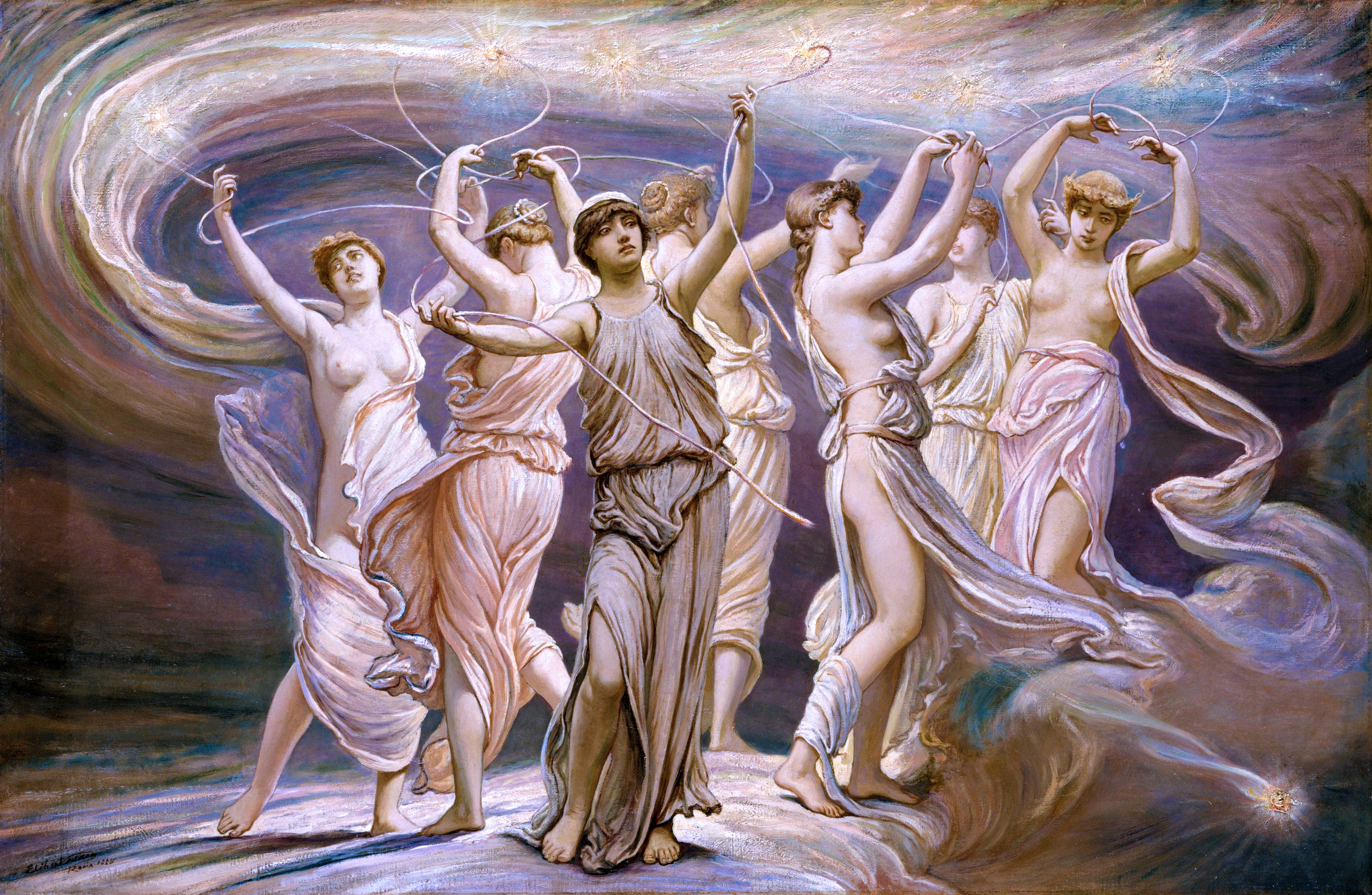1. Family and Lineage

Taygete is primarily known as one of the seven Pleiades, the daughters of the Titan Atlas and the Oceanid Pleione. Her sisters include Maia, Alcyone, Merope, Celaeno, Electra, and Sterope. Through her union with Zeus, Taygete became the mother of Lacedaemon, the mythical founder of Sparta. She is also considered an ancestor of Helen of Troy, establishing her as a significant figure in the genealogical lines of Greek heroes and legendary figures.
2. Mythology
The myths surrounding Taygete primarily revolve around her encounters with the powerful Olympian god Zeus, her close relationship with Artemis, and her role in establishing significant lineages.
2.1. Zeus's Pursuit and Transformation
As Zeus, known for his numerous romantic pursuits, sought to overpower Taygete, she fervently invoked her protectress, the goddess Artemis. To shield Taygete from Zeus's advances, Artemis compassionately transformed her into a beautiful doe with magnificent golden horns. This act of divine intervention highlights Artemis's role as a guardian of nymphs and a defender against unwanted attention. The myth subtly blurs the distinction between Taygete in her human form and her transformed doe form, suggesting a deep connection between the nymph and the animal.
2.2. The Ceryneian Hind
The golden-horned doe into which Taygete was transformed is often identified with the famous Ceryneian Hind, a creature central to one of Heracles's Twelve Labours. The uncommon depiction of a female doe with golden horns in Greek mythology, when most female deer species do not possess antlers, has led some scholars to speculate on a connection to reindeer, which are known for both male and female antlers. The ancient Greek poet Pindar, in his third Olympian Ode, alludes to this connection, describing "the doe with the golden horns, which once Taygete had inscribed as a sacred dedication to Artemis Orthosia" (often translated as "right-minded" Artemis). The association of Artemis with Orthia, also referred to as Orthosia, was a recognized aspect of her cult from at least the sixth century BCE. Pindar's account suggests that Taygete's transformation was not merely an escape but also an offering to Artemis, implying that the doe-form, even after being pursued by Heracles, continued to exist in some mythical sense. The mythologist Karl Kerenyi noted the difficulty in distinguishing between the divine beast, the heroine, and the goddess in such narratives, emphasizing the deep symbolic layers within Greek mythology.
2.3. Offspring and Marriage
Despite her initial flight from Zeus, Taygete eventually bore him two sons. According to the geographer Pausanias, Taygete conceived Lacedaemon, who is regarded as the mythical founder of the city of Sparta. Pausanias also credits her with conceiving Eurotas through Zeus. Furthermore, Pausanias recorded that the "rape of Taygete" was depicted on a throne at Amyclae, indicating the significance of this event in ancient art and tradition. In other accounts, Taygete is described as the wife of Lacedaemon, sometimes referred to as Sparta itself, and their son together was Himerus. This dual parentage for Lacedaemon-either directly through Zeus and Taygete or through Lacedaemon and Taygete (who might be considered his wife)-reflects variations in mythological traditions.
2.4. Other Traditions
While the most common account describes Taygete as a daughter of Atlas and Pleione, a rare variant of the myth suggests she was the daughter of Agenor, a Phoenician king. This alternative lineage appears in texts such as the Trojan War Chronicle by Dictys Cretensis. Beyond written accounts, her story and imagery, particularly her transformation and association with Zeus, were also reflected in ancient art, as evidenced by the depiction on the throne at Amyclae.
3. Naming of Mount Taygetos
Mount Taygetos, a prominent mountain range in Laconia, a region within the Peloponnese peninsula of Greece, was named in honor of Taygete. This mountain was considered her traditional haunt and was a sacred site dedicated to the goddess Artemis, whom Taygete served as a companion. The association between Taygete and the mountain underscores her enduring presence within the geography and mythology of ancient Greece.
4. Genealogy
The following table illustrates Taygete's family connections as described in various mythological traditions:
| Parent 1 | Parent 2 | Offspring | Notes |
|---|---|---|---|
| Atlas | Pleione | Taygete | One of the seven Pleiades |
| Zeus | Taygete | Lacedaemon | Mythical founder of Sparta |
| Zeus | Taygete | Eurotas | Also a son by Zeus |
| Lacedaemon (sometimes called Sparta) | Taygete | Himerus | Son from their marriage |